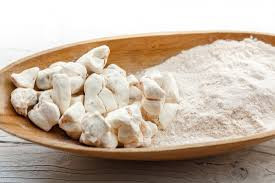
Baobab powder, extracted from the fruit of the baobab tree, contains nearly four times the vitamin C of oranges and is rich in essential minerals such as potassium and magnesium. Zimbabwe-based entrepreneur Gus Le Breton, co-founder of B’Ayoba, a company that produces baobab powder, spoke with AfricanOptimist’s Sanja Göhre about the fruit’s commercial potential and his journey of penetrating international markets. Le Breton also chairs the African Baobab Alliance. With just over 700 million of Africans living in rural areas, growing rural economies remains one of the biggest challenges for reversing extreme poverty on the continent. For Zimbabwean entrepreneur Gus Le Breton, a potential solution with a lucrative future, lies with wild-harvested products like those from indigenous baobab and marula trees, natural resources that grow in abundance amid local rural communities.
“Baobab is something where the very, very poorest people in the community can benefit from selling baobab, and in fact almost preferentially do, because there’s no raw material that’s required, there’s no inputs that are required, you don’t need fertiliser, you don’t need seed, you don’t need anything to harvest a baobab fruit. Literally, if you’ve got two arms and two legs, you can harvest a baobab fruit.”
Baobab processors also stand to benefit from the growing potential of this niche product. The baobab market is projected to expand from $2.7 billion in 2024 to $6.2 billion by 2032, with a compound annual growth rate of 11% during this period.
“So if you are an impact investor and you are looking at some sort of business opportunity that is going to benefit really the bottom of the pyramid people,” says Le Breton, “you could not get better than this.” Traditional uses of the baobab tree
Baobab trees grow in 33 African countries, from very dry areas with rainfall below 400 mm/year to coastal areas with rainfall of 1,200 mm/yr. Technically a succulent, the oldest specimen was a Zimbabwean tree, carbon-dated at 2,450 years. The trees are highly resilient in the face of droughts and climatic conditions, and generally produce fruit abundantly every one to two years.
Historically, baobab derivatives – such as powder from its nutrient-rich fruit pulp, herbal teas and medicines from its leaves and funicles (the thin cord attaching the seed to the fruit wall), and rope from its bark – were widely used locally. However, it wasn’t until Le Breton arrived that these products were viewed through a commercial lens.
“They all thought I was completely nuts … I’d say to rural people, ‘You know, there’s these trees, you have eaten the fruit your whole life, what about selling it?’ And they would just laugh at me and it was like, ‘Who’s ever going to buy this? I mean, they’re free. You can pick them up off the ground. Why would anyone pay money for that?’”
For Le Breton, the key to stopping the felling of baobab trees for firewood – an all-too-common practice as local communities cleared land for cash crops – was to make this indigenous resource economically valuable and viable. He believed that if baobab trees could generate income, local communities would protect them and ensure their preservation.
Transforming a traditional fruit into a marketable product
But how does one transform a resource with a long history of traditional use into something with real commercial value?
From early on, Le Breton set his sights on the export market, aware of the strong stigma against local products within Africa at the time. He also chose to start by producing baobab oil rather than powder.
“We weren’t sure that we could immediately master the kind of hygiene issues required to ensure a safe food product, working at a grassroots community level,” he said of the decision.
However, oil production came with its own set of challenges, as Le Breton and a few small communities in northeast Zimbabwe struggled to produce a high-quality product at scale.
“The quality was very unpredictable; it was a natural product,” he said. “Each batch that we produced looked a bit different, no significant-sized cosmetic buyer was ever going to buy an ingredient that was … basically being produced in such a kind of small-scale and slightly rinky dink approach.”
It was in fact with another oil, marula oil, that Le Breton had his first taste of success after he and four other organisations got together in a bid to standardise marula oil production and pooled their resources to market it. After international retailer The Body Shop started buying the oil and using it in one of their make-up products, demand for the oil grew significantly, to the point where it is now a well established product in the industry.
Securing European market access for baobab powder
While quality issues in oil production were significant, the bigger challenge lay in getting baobab powder to the international market.
“There was a group of regulations, which still exist to this day, around food safety in the EU that basically said it was illegal to sell a food ingredient on the European market without first demonstrating convincingly that it was safe. [This] means putting it through toxicological trials — which I understand, if it’s a food ingredient that’s just been cooked up in a laboratory — but this is a traditional food ingredient that people have literally consumed safely for thousands of years. But, unfortunately, the regulators didn’t see it that way,” Le Breton says.
The EU novel foods regulatory framework was established in the 1990s to protect European countries from foods that had been genetically modified, and Le Breton had no choice but to follow the stringent rules and regulations regarding toxicological testing and other criteria to give baobab powder a chance in the EU.
As part of an association of companies and NGOs trying to promote trade in indigenous plant products from southern Africa, Le Breton and his team were able to submit an application to the European Food Safety Authority. The process took four years from 2004 to 2008 and cost about $500,000. Once attained, it was followed up quickly by the United States’ Food and Drug Administration’s GRAS (generally recognised as safe) approval.
Le Breton views these approvals as a significant victory and milestone for producers of indigenous foods from southern Africa. They can now apply for approvals that are more affordable and somewhat faster.
“We were the first people to highlight the fact that these regulations were set up to prevent genetically modified organisms from being launched, not to prevent indigenous foods. And as a result of that, the pressure that we brought to bear, the European Food Safety Authority introduced a separate category of Novel Foods based on a traditional food, which does not require the same depth of toxicological testing as the GM foods do.” Le Breton himself is now working on three different Novel Foods applications for traditional or indigenous foods from southern Africa, including the bambara nut.
—How We Made It in Africa










